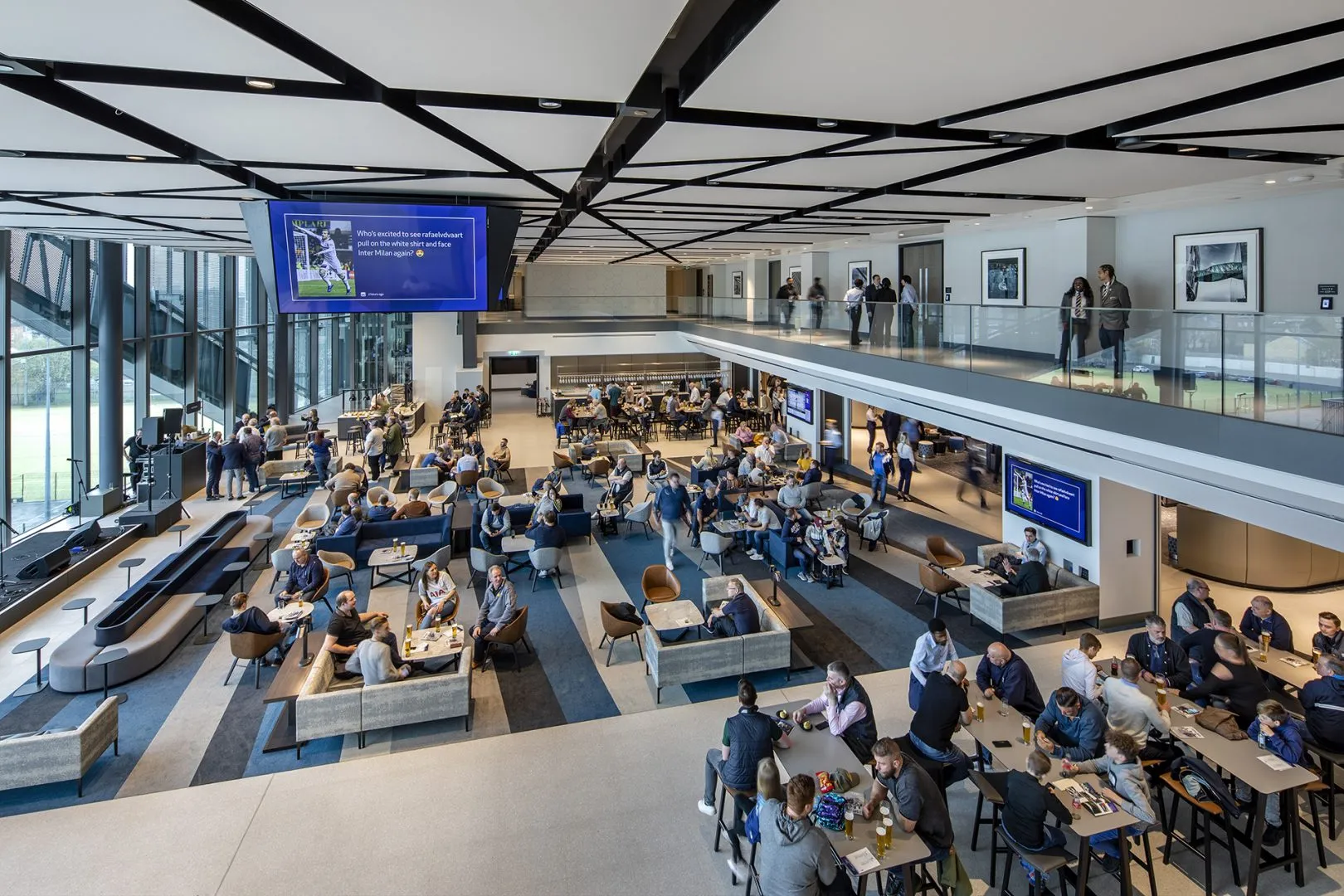Arguably the most impressive stadium in English football, the Tottenham Hotspur Stadium was officially opened in 2019 as the new home of Tottenham Hotspur FC.
We thought it would be a good idea to dedicate this article to the Tottenham experience; its rich history, the facilities it possesses, the stadium tours you can go on, the tickets you can buy and crucially, how a club with Tottenham’s history have managed to bag themselves such a top quality stadium. Did they bother installing a trophy cabinet? (Okay, they have won eight FA Cups, but you have to be of a certain vintage if you can remember any of those wins)
The History of the Tottenham Hotspur Stadium
White Hart Lane
 When Tottenham Hotspur FC was formed in 1882 they used to play their matches on public land at Tottenham marshes. As they began to attract large crowds, they needed to move to somewhere a bit bigger. Spurs first rented a pitch at Northumberland Park, but in 1899 settled in a piece of land owned by Charringtons Brewery, behind the White Hart pub – White Hart Lane was born.
When Tottenham Hotspur FC was formed in 1882 they used to play their matches on public land at Tottenham marshes. As they began to attract large crowds, they needed to move to somewhere a bit bigger. Spurs first rented a pitch at Northumberland Park, but in 1899 settled in a piece of land owned by Charringtons Brewery, behind the White Hart pub – White Hart Lane was born.
That old ground saw some truly great players – Bill Nicholson, Danny Blanchflower and Jimmy Greaves in the 60s, Glenn Hoddle and Ossie Ardiles in the 80s, Gary Lineker, Jürgen Klinsmann and David Ginola in the 90s, Dimitar Berbatov and Gareth Bale in the noughties. And we haven’t even mentioned Helder Postiga.
The problem was, though, that White Hart Lane was just too small for where Tottenham wanted to be, with a capacity of just 36,000 – not big enough for a team that wanted to be competing for the Premier League title and a European trophy. They decided to explore other options.
Planning the Tottenham Hotspur Stadium
In 2007, Tottenham announced that they were looking at the redevelopment of the White Hart Lane site as one option in their pursuit of a larger home ground. Named the Northumberland Development Project, the plans were controversial – they required 8 locally listed buildings to be demolished, as well as two nationally listed. After a long wait involving appeals, High Court rulings and Eric Pickles, eventually the plans were approved, with Compulsory Purchase Orders for nearby property, in 2014.
Building work for the project had actually begun in 2012, but they did not start construction on the stadium itself until after the various disputes were settled and the land acquired in 2015. Demolition of the old White Hart Lane stadium began after Spurs’ final home match of the 2016-17 season (which saw Spurs win against Man United 2-1).
Building the Tottenham Hotspur Stadium
The Club have worked hard to ensure they have reflected the history of Tottenham Hotspur in the stadium’s construction. They have mixed the concrete foundations of White Hart Lane with concrete to form the foundations of the new stadium, bricks from the old East Stand have been used to make the Shelf Bar, and have placed heritage plaques around the stadium to mark out the points of the old stadium.
In the construction process Spurs have decorated the exterior of the stadium with 35,000 decorative tiles, over 4,800 metal panels and over 2,500 glass panels.
While construction was taking place, Tottenham Hotspur became the first club to play their Premier League home games at Wembley Stadium (although Arsenal did play Champions League games there previously). They extended their stay there well into the 2018-19 season following further delays – the delay down to a wait for the issuing of a safety certificate.
Eventually, the first team managed to play their first match in the stadium in April 2019 – a game against Crystal Palace that they ended up winning 2-0. Son Heung-min scored the first official goal in the Tottenham Hotspur Stadium.
Tottenham Hotspur Stadium facilities
The stadium has been designed to be one of the best in the world. Here are some quick facts:
Stadium capacity: 62,850
Stadium Height: 48 metres
Number of internal floors: 9
Gross internal area: 119,945 Metres squared
Number of LED screens: 4
Number of LED Floodlights: 324
Number of Season ticket holders: 42,000
Number of Wheelchair Bays: 265
These facts merely scratch the surface. There is a large open area, as big as Trafalgar Square, to act as the main access point for home fans, which can be used for community activities. While they designed it as a bowl, there are still four distinct stands – the South Stand has been designated as ‘the home end’, and is the largest single-tier stand in the country. This is where Spurs fans create the atmosphere.
The pitch is much bigger than the one that was at White Hart Lane, and there are two of them. In order to be able to have NFL games played in the stadium, there is a retractable pitch which makes way for a synthetic turfed pitch. Spurs were the first British team to host an NFL game at their stadium (Wembley being the only other Stadium in the UK to have done it).
For the players, they have fitted the changing rooms with hydrotherapy pools, warm-up areas, lounges, restaurants and creches. For fans, you can visit one of the many bars (including the longest bar in Europe – the Goal Line Bar at 65m long), plus there is an in-house bakery, countless food outlets and micro-brewery – which can produce 1 million pints a year and deliver 10,000 pints a minute.
For the fan that likes to stay connected, there are WiFi access points with Bluetooth beacons to give it greater bandwidth than any other stadium, and plenty of premium lounges for fans that want that little bit extra.
The Tottenham Experience

This is also where you would begin stadium tours.
Tottenham Hotspur Stadium Tours
What we really like about the Tottenham stadium tours is that you can select a self-guided tour. You don’t have to trudge around in a group of strangers, you are free to roam about and explore for yourselves. Highlights include seeing how the players prepare for a match and walking down the tunnel to the pitch. It’s fascinating to see behind the scenes at such an impressive stadium, even if you’re not Spurs fans. You can also take the Spurs stadium virtual tour here.
Why is it called the Tottenham Hotspur Stadium?
It’s not the most inspiring name, is it? Well, it all comes down to money. Spurs want to sell the naming rights to the stadium, but they also want to make sure they get the right price for it. The stadium is thought to have cost around £1.2 billion in total, and they want to make some of that back through naming rights – around £20 million a year. So far, nobody seems to meet that valuation, but it only seems a matter of time before we have to get used to calling it something different.
How to get to the Tottenham Hotspur Stadium
The Tottenham Hotspur Stadium is accessible from a number of London Overground, London Underground and National Rail stations. White Hart Lane is the closest, just 200m away, but Tottenham Hale, Northumberland Park and Seven Sisters are all within walking distance (although some are 20-25 minutes away). There is a walkway from White Hart Lane station to the ground, similar to the one at Wembley.
In terms of buses, there are supposedly 144 buses an hour that pass by the stadium. Look for the routes 149, 259, 279, 349, and W3.
What hospitality options are available at the Tottenham Hotspur Stadium?
As you would expect from a modern stadium in the Premier League, Spurs have some fantastic hospitality packages. With Tottenham tickets quite hard to come by Our favourite is the Premium Experience: You get exclusive access to the premium tier cash bars pre and post match, a luxury padded seat, fast track entrance to the stadium, unlimited light bowl food and a complimentary drink at half time. A wonderful way to experience a Premier League match.
Final Word
The Tottenham Hotspur Stadium is one of the finest stadiums in the country, and going there is a truly unique experience. If you are interested in going, our advice is to make a full day of it. Maybe even a weekend.
Head down to London early – book yourself in for a stadium tour and get the Tottenham Experience. Spend some time having a drink and some food with season ticket holders around the ground before going for the Premium Experience.
Try to get tickets for the best games in English football – the North London derby. Some of the Spurs vs Arsenal matches have been the best the Premier League has ever seen, and with Arsenal having a chance of winning the title at the time of writing, there will be added spice to the match.









